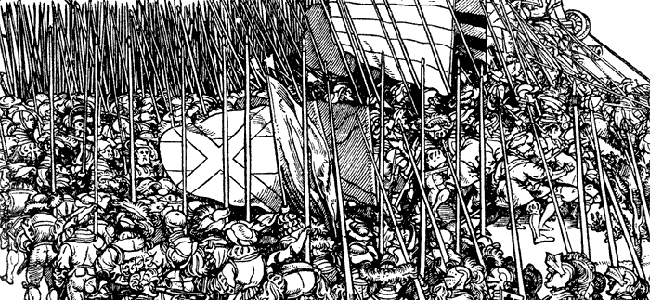 |
Dynamic Defense |

 The
perception of the medieval siege would have us believe that
defenders of artillery forts stayed huddled behind their walls, and atop
ramparts and bastions. To the contrary, they employed a
dynamic defense, placing and maneuvering soldiers outside the base
fort to hold back besiegers before they came close.
The
perception of the medieval siege would have us believe that
defenders of artillery forts stayed huddled behind their walls, and atop
ramparts and bastions. To the contrary, they employed a
dynamic defense, placing and maneuvering soldiers outside the base
fort to hold back besiegers before they came close.
Yes - outside. Theirs was defense in depth.
Actions outside the base fort were numerous and often small in scale. As few as a half dozen soldiers reconnoitered their enemy and engaged in skirmishes. Small patrols of defenders tried to penetrate their enemy's lines to seize supplies. Besiegers probed defending lines. Sometimes, one side or the other launched a small-scale attack involving a few companies to throw their enemy out of some outlying fortification. In particular, defenders assaulted the approaching trenches their besiegers were digging. Fighting could be at close quarters, furious and vicious. Cavalry was brought in, light and in small units, to sweep down on a little cluster of enemy, decimate them, then gallop away before a counterattack. The best way to catch such mounted attackers was for the other side to employ cavalry, too.
One result of the defense in depth was that the besieged did not remain cooped up and massed together, thereby reducing the chance of an epidemic doing the work for the besiegers. Furthermore, troops could be rotated between the fort itself and its outer defenses, which seemed to have improved morale.
Not until the defenders' numbers were so laid waste to did they cease ranging out.

The term 'body of a place' was used to refer to the 'base fort' or what's within the innermost ditch because assorted fortifications integral to the defense were constructed beyond the ditch. It was these the besiegers first encountered, hammered and had to take, thereby suffering casualties and delays - and any delay jacked up the cost to the besiegers in supplies and attrition in the ranks - and any delay provided that much more time for a field army on the side of the defenders to march in. Plus, these outworks provided bases from which defenders could make sorties, anything from reconnaissance to counterattacks.
The first defensive feature outside the ditch was a triangular shaped structure, the ravelin, that stood in front of the bridge and gate to defend the way for supply and communication.
| Back | Ravelin |
|
|
|